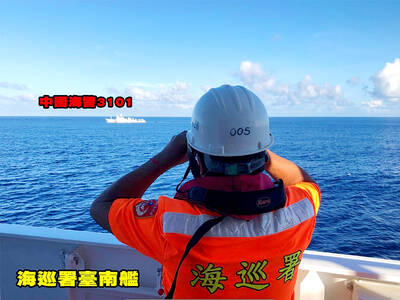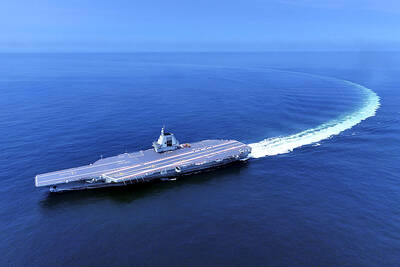China has launched new spy satellites that might further threaten Taiwanese warships in the case of a military clash, a US expert said.
“Beijing’s looming ability to overwhelm Taiwan’s combat ships is a key reason Washington must help Taipei to obtain submarines,” veteran military analyst Richard Fisher told the Taipei Times.
A Long March-48 rocket was used to launch the Yaogan-21 remote sensing satellite and the Tiantuo-2 experimental satellite on Sept. 8, it was reported this week by Jane’s Defence Weekly.
The rocket was fired from the Taiyuan Satellite Launch Center.
Officially, the satellites are supposed to be used for scientific experiments, natural resource surveys, estimating crop yields and disaster relief.
However, US experts believe the mission of these remote sensing satellites is ocean surveillance.
“The Yaogan-20 electronic intelligence satellite can indeed increase the People’s Liberation Army’s [PLA] ability to find and target large naval ships,” said Fisher, a senior fellow in Asian Military Affairs with Washington-based think tank the International Assessment and Strategy Center.
The PLA is now able to collate optical, radar and electronic signals intelligence (ELINT) satellite data to target ships at sea — capabilities that Russia and the US have had for many years, Fisher said.
“This constellation of satellites will allow the PLA to target Taiwan’s large ships with new anti-ship ballistic missiles in coordination with strike aircraft,” he said.
The satellites will enable Beijing to find Taiwan’s navy at sea and enable fighter planes to target the ships with missiles, he added.
News of the launch comes as the Ministry of National Defense announced that while Taipei still wants to buy new submarines from the US, continuing delays have caused the nation to initiate a program to build four diesel-electric attack submarines for a total budget of about NT$150 billion (US$4.9 billion).
“The nation will pursue both foreign procurement and domestic building plans in tandem,” ministry spokesman Major General David Lo (羅紹和) said.
“We welcome the US and other free, democratic counties to collaborate with us to advance our indigenous submarine-building program,” he said.
Even the most sophisticated and modern satellites have great difficulty locating submarines at sea, particularly if the vessels are in deep water.
Jane’s Defence Weekly said the latest Chinese satellite launch was one of a series to set up a grouping of spy vehicles that could detect surface ships’ radar emissions and determine their location through triangulation.
“Tiantuo-2 carries four video cameras capable of streaming real-time data on moving objects,” the magazine said.
It reported there was speculation the system would be capable of tracking objects on the Earth’s surface using real-time ground-controlled directional alignment of the cameras.
“This is the golden age for China’s space program,” senior analyst and China Project Manager for the Union of Concerned Scientists Gregory Kulacki said in a recent interview.
“China invests more in space. They have a younger, larger, more highly motivated cadre of space professionals focused on clear objectives,” Kulacki said.

The first two F-16V Bock 70 jets purchased from the US are expected to arrive in Taiwan around Double Ten National Day, which is on Oct. 10, a military source said yesterday. Of the 66 F-16V Block 70 jets purchased from the US, the first completed production in March, the source said, adding that since then three jets have been produced per month. Although there were reports of engine defects, the issue has been resolved, they said. After the jets arrive in Taiwan, they must first pass testing by the air force before they would officially become Taiwan’s property, they said. The air force

The Coast Guard Administration (CGA) yesterday said it had deployed patrol vessels to expel a China Coast Guard ship and a Chinese fishing boat near Pratas Island (Dongsha Island, 東沙群島) in the South China Sea. The China Coast Guard vessel was 28 nautical miles (52km) northeast of Pratas at 6:15am on Thursday, approaching the island’s restricted waters, which extend 24 nautical miles from its shoreline, the CGA’s Dongsha-Nansha Branch said in a statement. The Tainan, a 2,000-tonne cutter, was deployed by the CGA to shadow the Chinese ship, which left the area at 2:39pm on Friday, the statement said. At 6:31pm on Friday,

The Chinese People’s Liberation Army Navy’s (PLAN) third aircraft carrier, the Fujian, would pose a steep challenge to Taiwan’s ability to defend itself against a full-scale invasion, a defense expert said yesterday. Institute of National Defense and Security Research analyst Chieh Chung (揭仲) made the comment hours after the PLAN confirmed the carrier recently passed through the Taiwan Strait to conduct “scientific research tests and training missions” in the South China Sea. China has two carriers in operation — the Liaoning and the Shandong — with the Fujian undergoing sea trials. Although the PLAN needs time to train the Fujian’s air wing and

STRIKE: Some travel agencies in Taiwan said that they were aware of the situation in South Korea, and that group tours to the country were proceeding as planned A planned strike by airport personnel in South Korea has not affected group tours to the country from Taiwan, travel agencies said yesterday. They added that they were closely monitoring the situation. Personnel at 15 airports, including Seoul’s Incheon and Gimpo airports, are to go on strike. They announced at a news conference on Tuesday that the strike would begin on Friday next week and continue until the Mid-Autumn Festival next month. Some travel agencies in Taiwan, including Cola Tour, Lion Travel, SET Tour and ezTravel, said that they were aware of the situation in South Korea, and that group